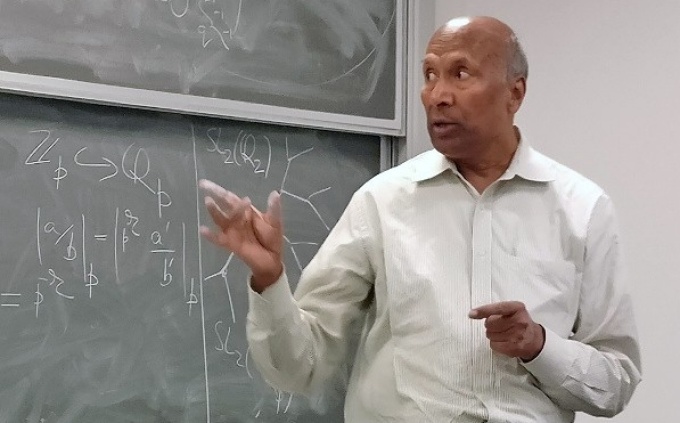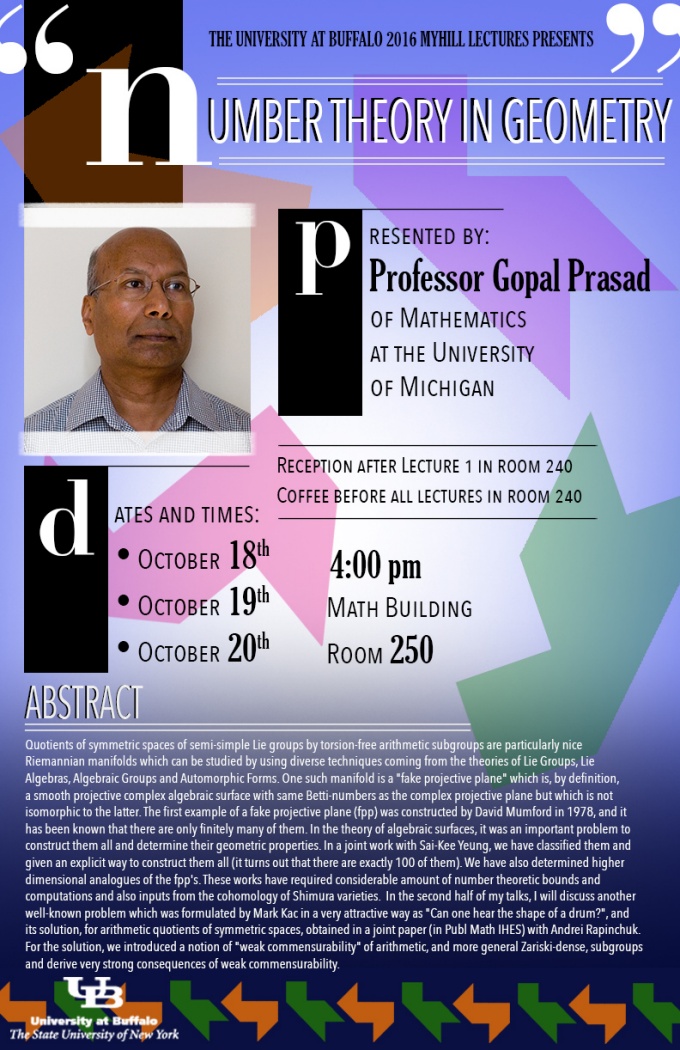Myhill Lecture Series 2016
Gopal Prasad
“Number Theory in Geometry”

Gopal Prasad, Myhill Lecture Series 2016. Photograph courtesy of John Ringland.
Gopal Prasad, the Raul Bott Professor of Mathematics at the University of Michigan, delivered the prestigious Myhill Lectures on October 18-20, 2016. The lecture series, titled “Number Theory in Geometry,” drew an overflow crowd to Math 250 for the first talk, an introduction to the history of number theory in geometry.
In the second lecture Prasad discussed his groundbreaking work giving a complete classification of the so-called “fake projective planes.” The final lecture was devoted to the famous mathematical question “can you hear the shape of a drum.” The answer is “no”, as there are example of two drums with completely different shapes that sound exactly alike. Such objects are known as isospectral but not isometric manifolds. Prasad’s work shows that in higher dimensions with some reasonable assumptions the answer is “yes”!
Prasad earned his Ph.D. in 1976 from the University of Bombay (now Mumbai). After visiting appointments at Yale and the Institute for Advanced Study in Princeton, he joined the faculty at the Tata Institute of Fundamental Research in Mumbai, where he stayed for 20 years, eventually serving as Dean of the School of Mathematics.
In 1990 he was an invited speaker at the International Congress of Mathematicians in Kyoto. In 1992 he was recruited to the University of Michigan where he has remained ever since. In 1998 he received a Guggenheim Fellowship and in 2006 a Humboldt Senior Research Award. He is a fellow of the Indian National Science Academy, the Indian Academy of Sciences and the American Mathematical Society. In 2008, Prasad became the first Raul Bott Professor of Mathematics at Michigan.
On this page:
Paper Abstract
Quotients of symmetric spaces of semi-simple Lie groups by torsion-free arithmetic subgroups are particularly nice Riemannian manifolds which can be studied by using diverse techniques coming from the theories of Lie Groups, Lie Algebras, Algebraic Groups and Automorphic Forms. One such manifold is a "fake projective plane" which is, by definition, a smooth projective complex algebraic surface with same Betti-numbers as the complex projective plane but which is not isomorphic to the latter.
The first example of a fake projective plane (fpp) was constructed by David Mumford in 1978, and it has been known that there are only finitely many of them. In the theory of algebraic surfaces, it was an important problem to construct them all and determine their geometric properties. In a joint work with Sai-Kee Yeung, we have classified them and given an explicit way to construct them all (it turns out that there are exactly 100 of them). We have also determined higher dimensional analogues of the fpp's. These works have required considerable amount of number theoretic bounds and computations and also inputs from the cohomology of Shimura varieties.
In the second half of my talks, I will discuss another well-known problem which was formulated by Mark Kac in a very attractive way as "Can one hear the shape of a drum?", and its solution, for arithmetic quotients of symmetric spaces, obtained in a joint paper (in Publ Math IHES) with Andrei Rapinchuk. For the solution, we introduced a notion of "weak commensurability" of arithmetic, and more general Zariski-dense, subgroups and derive very strong consequences of weak commensurability.
Event Poster
Gopal Prasad - Wikipedia Entry
According to Wikipedia:
Prasad’s research interests span the fields of Lie groups, their discrete subgroups, algebraic groups, arithmetic groups, geometry of locally symmetric spaces, and representation theory of reductive p-adic groups.
Prasad has received the Guggenheim Fellowship, the Humboldt Senior Research Award, and the Raoul Bott Professorship at the University of Michigan. He was awarded the Shanti Swarup Bhatnagar prize (by the Council of Scientific and Industrial Research of the Government of India), and has received Fellowships in the Indian National Science Academy, among numerous other honors. In 2012 he became a fellow of the American Mathematical Society.
Prasad was the Managing Editor of the Michigan Mathematical Journal for over a decade, an Associate Editor of the Annals of Mathematics for six years, and is an editor of the Asian Journal of Mathematics since its inception.
He earned his bachelor's degree with honors in Mathematics from Magadh University in 1963. Two years later, in 1965, he received his masters in Mathematics from Patna University. After a brief stay at the Indian Institute of Technology Kanpur in their Ph.D. program for Mathematics, Prasad joined TIFR for his PhD program in 1966. There Prasad began a long and extensive collaboration with his advisor M. S. Raghunathan on several topics including the study of lattices in semi-simple Lie groups. In 1976, Prasad received his Ph.D. from University of Mumbai. Prasad became an Associate Professor at TIFR in 1979, and a Professor in 1984. He left TIFR to join the faculty at the University of Michigan in Ann Arbor in 1992, where he is the Raoul Bott Professor of Mathematics.
Prasad's early work was on discrete subgroups of real and p-adic semi-simple groups. He proved the "strong rigidity" of lattices in real semi-simple groups of rank 1 and also of lattices in p-adic groups, see [1] and [2]. He then tackled group-theoretic and arithmetic questions on semi-simple algebraic groups. He proved the "strong approximation" property for simply connected semi-simple groups over global function fields [3]. In collaboration with M. S. Raghunathan, Prasad determined the topological central extensions of these groups, and computed the "metaplectic kernel" for isotropic groups, see [11], [12] and [10]. Later, together with Andrei Rapinchuk, Prasad gave a precise computation of the metaplectic kernel for all simply connected semi-simple groups, see [14]. Prasad and Raghunathan have also obtained results on the Kneser-Tits problem, [13].
In 1987, Prasad found a formula for the volume of S-arithmetic quotients of semi-simple groups, [4]. Using this formula and certain number theoretic and Galois-cohomological estimates, Armand Borel and Gopal Prasad proved several finiteness theorems about arithmetic groups, [6]. The volume formula, together with number-theoretic and Bruhat-Tits theoretic considerations led to a classification, by Gopal Prasad and Sai-Kee Yeung, of fake projective planes (in the theory of smooth projective complex surfaces) into 28 non-empty classes [21] (see also [22] and [23]). This classification, together with computations by Donald Cartwright and Tim Steger, has led to a complete list of fake projective planes. This list consists of exactly 50 fake projective planes, up to isometry (distributed among the 28 classes). This work was the subject of a talk in the Bourbaki seminar.
Prasad has worked on the representation theory of reductive p-adic groups with Allen Moy. The filtrations of parahoric subgroups, referred to as the "Moy-Prasad filtration", is widely used in representation theory and harmonic analysis. Moy and Prasad used these filtrations and Bruhat-Tits theory to prove the existence of "unrefined minimal K-types", to define the notion of "depth" of an irreducible admissible representation and to give a classification of representations of depth zero, see [8] and [9].
In collaboration with Andrei Rapinchuk, Prasad has studied Zariski-dense subgroups of semi-simple groups and proved the existence in such a subgroup of regular semi-simple elements with many desirable properties, [15], [16]. These elements have been used in the investigation of geometric and ergodic theoretic questions. Prasad and Rapinchuk introduced a new notion of "weak-commensurability" of arithmetic subgroups and determined "weak- commensurability classes" of arithmetic groups in a given semi-simple group. They used their results on weak-commensurability to obtain results on length-commensurable and isospectral arithmetic locally symmetric spaces, see [17], [18] and [19].
Together with Jiu-Kang Yu, Prasad has studied the fixed point set under the action of a finite group of automorphisms of a reductive p-adic group G on the Bruhat-Building of G, [24]. In another joint work, Prasad and Yu determined all the quasi-reductive group schemes over a discrete valuation ring (DVR), [25].
In collaboration with Brian Conrad and Ofer Gabber, Prasad has studied the structure of pseudo-reductive groups, and also provided proofs of the conjugacy theorems for general smooth connected linear algebraic groups, announced without detailed proofs by Armand Borel and Jacques Tits; their research monograph [26] contains all this. The monograph [27] contains a complete classification of pseudo-reductive groups, including a Tits-style classification and also many interesting examples. The classification of pseudo-reductive groups already has many applications. There was a Bourbaki seminar in March 2010 on the work of Tits, Conrad-Gabber-Prasad on pseudo-reductive groups.
See more information and footnotes on Wikipedia.
